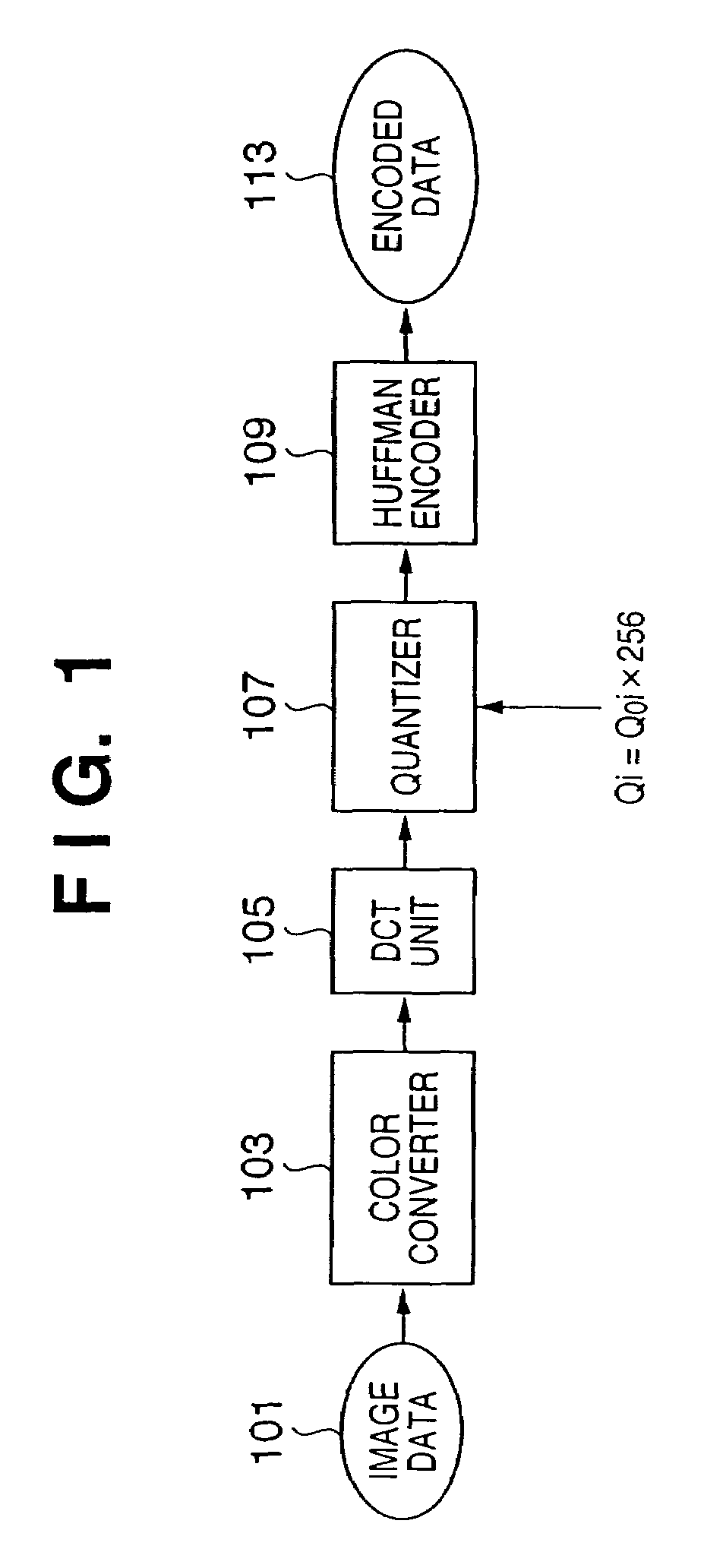Image decoding apparatus and its control method
a decoding apparatus and image technology, applied in the field of decoding technique of encoded image data, can solve the problems of deterioration of image quality, inability to suppress re-compression, and inability to improve image quality, etc., and achieve the effect of high precision
- Summary
- Abstract
- Description
- Claims
- Application Information
AI Technical Summary
Benefits of technology
Problems solved by technology
Method used
Image
Examples
first embodiment
[0044]FIG. 11 is a block diagram of an image decoding apparatus which decodes both baseline JPEG data and Extended sequential DCT-based JPEG data in this embodiment.
[0045]Referring to FIG. 11, reference numeral 1201 denotes an encoded data input unit which is a device for accessing a storage medium such as a memory card or the like when an input source is the storage medium, or a network interface when an encoded image data file on the network is to be input. That is, the type of input unit is not particularly limited.
[0046]Reference numeral 1203 denotes a header interpreter which interprets a frame start marker (SOF0 marker) of a head of the input encoded data to check if the input encoded data is encoded data of color image data which is expressed by 8 bits per color (each color component which forms one pixel) (to be referred to as baseline JPEG encoded data hereinafter) or encoded data of color image data which is expressed by 12 bits per color (each color component which forms ...
second embodiment
[0085]The second embodiment will explain a case wherein image data which is expressed by 16 bits per color component undergoes a JPEG encoding process to obtain an encoded bitstream, and that encoded bitstream is decoded to output an image which is expressed by 8 bits per color component.
[0086]FIG. 5 is a block diagram of an image processing apparatus (copying machine) to which the second embodiment is applied.
[0087]Referring to FIG. 5, reference numeral 501 denotes a scan unit which scans a document image with a precision of 16 bits per color component; 502, an encoding unit; 503, a decoding unit; and 504, a print unit which receives and prints an image which is expressed by 8 bits per color component. Reference numeral 505 denotes a storage device which stores encoded data output from the encoding unit 502. The decoding unit 503 reads out encoded data from the storage device 505 in accordance with the print speed of the print unit 504, and performs a decoding process. As a result,...
third embodiment
[0122]In the second embodiment, the number of bits to be processed by the image input device is larger than that to be processed by the image output device.
[0123]The third embodiment will explain a case wherein this relationship is reversed. That is, a case will be explained wherein an 8-bit input image is encoded, and the obtained encoded image data (baseline JPEG encoded data) is decoded to generate a 16-bit image.
[0124]Normally, in order to obtain such decoded image, an 8-bit decoded image per color component is generated first, and each color component is shifted by 8 bits to the left (to the MSB direction). However, the lower 8 bits of the generated 16-bit data are all “0”s, and the generated image data is no different from the 8-bit decoded result in terms of image quality.
[0125]Hence, the third embodiment will exemplify a case wherein 8-bit encoded data per color component (baseline JPEG data) is decoded to a 16-bit image per color component with a high precision.
[0126]FIG. 6...
PUM
 Login to View More
Login to View More Abstract
Description
Claims
Application Information
 Login to View More
Login to View More - R&D
- Intellectual Property
- Life Sciences
- Materials
- Tech Scout
- Unparalleled Data Quality
- Higher Quality Content
- 60% Fewer Hallucinations
Browse by: Latest US Patents, China's latest patents, Technical Efficacy Thesaurus, Application Domain, Technology Topic, Popular Technical Reports.
© 2025 PatSnap. All rights reserved.Legal|Privacy policy|Modern Slavery Act Transparency Statement|Sitemap|About US| Contact US: help@patsnap.com



